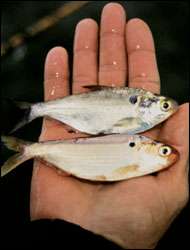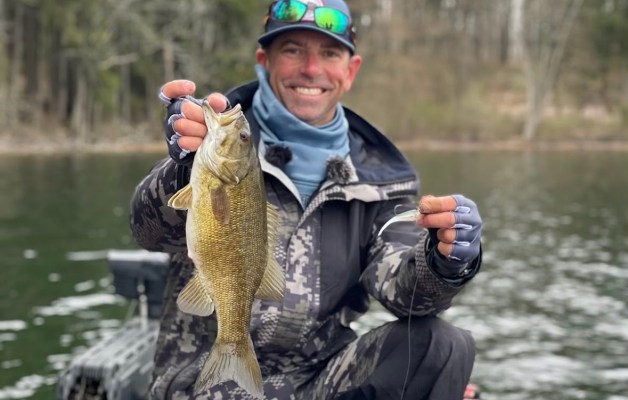
When Robert Hamilton won the 1992 Bassmaster Classic on Alabama's Logan Martin Lake, it wasn't — as many believe — due to using the perfect lure or finding the perfect structure. It wasn't even due to perfect luck.
Instead, Hamilton attributes his world championship to a tiny, silvery white fish named Dorosoma petenense, better known as the threadfin shad.
"My Classic win was almost totally dependent on shad," remembers Hamilton. "I could ride over the underwater structure I was fishing and see the shad on my depthfinder. When the baitfish were scattered, even though they were near the surface, I never caught any bass.
"It was only when the shad began to bunch tightly and hold deeper — 7 or 8 feet over the top of the structure — that I'd catch anything. The shad were so thick at times I couldn't even see the bottom, but those were the times bass started feeding.
"After the first day of seeing this, I wouldn't even stay in the area to fish unless the shad were like this."
Fast-forward a year, to the 1993 Classic on the same lake. Hamilton's shad never showed up, and his deeper structure holes never produced.
In contrast, winner David Fritts worked shallow structure and underwater cover, keying on underwater targets and — you guessed it — shad. At each place Fritts found and caught bass, he also saw plenty of baitfish activity.
"The two types of shad in our impoundments, threadfin and the gizzard shad (Dorosoma cepedianum), can have profound impacts on the entire aquatic ecosystem because they are such important foods — not only for bass, but also for many other species," says fishery scientist Dr. Loren Hill.
"Robert Hamilton and David Fritts are not the first anglers to win tournaments because of shad. The majority of bass tournaments, except for those held during the spring spawning season, can be attributed in some part to the presence of threadfin or gizzard shad. Most anglers just don't realize it."
Those are important words of praise for two fish about which the fisheries community has done little official research. Enough is known, however, to realize that the well-being of sportfish populations depends on threadfin and gizzard shad.
Shad, of course, are not the only food on the bass menu. Because bass are such opportunistic feeders, their diet includes such diverse items as crawfish, bluegill and other small sunfish, frogs, baby ducks, rainbow trout and even their own offspring. Because shad often comprise such a large proportion of the total fish population in a lake, however, they can influence the availability of these other creatures.
Although bass feed heavily on both gizzard and threadfin shad throughout most of the year, nature has its own ways of taking care of possible overpopulations of these prolific baitfish. Both species, the threadfin in particular, are especially sensitive to cold water.
In part, this temperature/stress relationship may be one of the reasons shad seem to be continually moving throughout a lake. These movements are not confined to the seasons, but in many instances are daily.
Over the years, anglers and guides have occasionally noticed these movements and been able to take advantage of them, because bass followed the shad. Professional guides on highland lakes have reported daily shad migrations that could be tracked for more than half a mile. In nearly every instance, bass follow behind and underneath the shad, feeding on them periodically.
These feeding binges appear to occur most often when the school of shad is more compressed, as it might be when it funnels along a ditch or channel, or when it rises or sinks over a ridge or other type of structure to a particular depth, as Hamilton found during his Classic win. These also happen to be natural ambush points.
"We can't pinpoint exactly what is occurring or why," says Hill, "because shad, as you can imagine, are not the easiest fish to study. They're too small for radio transmitters, and of course, they're eaten by the thousands every day.
"We do know that huge concentrations of shad will move into shallow water to seek shoreline cover during nocturnal hours. Often, it is to a mossbed, treeline or other type of vegetation; it is not simply to open, shallow water.
"Then, early in the morning, these same shad leave and head toward deeper water, where they roam throughout the day. Shad, in fact, spend much of their lives roaming throughout a lake, but these migrations into shallow water occur daily between spring and fall.
"We see shad when they're traveling in huge schools or swarms, and from time to time, anglers encounter them, and when they do, the fishing can be fantastic. Unfortunately, the movements into and out of shallow water are not always in such visible schools. It's only when some obstacle tends to bunch the baitfish that we really notice them.
"That is why not many people really know about this movement pattern at all."
According to research conducted by Hill, shad spawn in very shallow water, over sand, gravel, wood, vegetation and even mud. Water temperatures for gizzard shad at this time can be as cold as 57 degrees or as warm as 75 degrees, so the activity normally begins as early as mid-April in parts of their range.
Threadfin shad can have multiple spawning periods between April and August, as long as the water temperature ranges between 66 and 75 degrees, which is another possible explanation for their movements to shallow water each evening.
The eggs are adhesive and stick to the first hard surface they touch. As soon as the eggs are deposited, the adults leave. Incubation for both shad species takes up to three days and, although they may hatch near shore, they don't stay there long.
"Newly hatched shad larvae gradually migrate to pelagic areas (living near the surface of open areas of the lake) as they grow," says Hill. "They range from near the surface down to the pH breakline and thermocline, but both horizontal and vertical movements can change in response to water elevation, turbidity, storms and food availability — so it's easy to see that both gizzard and threadfin shad always keep a suitcase packed."
Once shad are located, the obvious question is how to take advantage of them to catch bass. The answer to that often depends on the season of the year as well as where the shad are located.
"In late spring, I like small crankbaits," explains Hamilton. "You fish around the school, keying on any structure or cover that may be available. You don't simply start casting through the shad.
"As summer progresses, I use larger and larger crankbaits, because the shad are getting larger. But in the autumn I switch to small crankbaits again because many of the shad are small, due to a late spawn. When bass are feeding heavily on schools of shad, sometimes 'matching the hatch' with the right size of lure is really important."
In the winter, when the water grows much colder, the shad migrate back out of the creeks and into main lake depths. On some lakes, this can easily be 40 to 60 feet deep. The fish kills occur most often in shallower lakes, or in sections of a lake that are primarily shallow, when the temperature drops quickly and then stays cold.
Although the shad continue to roam in the winter months, they generally remain in deep water because of their temperature tolerances. Gradually, as the water warms in early spring, they begin to move shallow and adhere to the in-and-out daily movement cycle.




